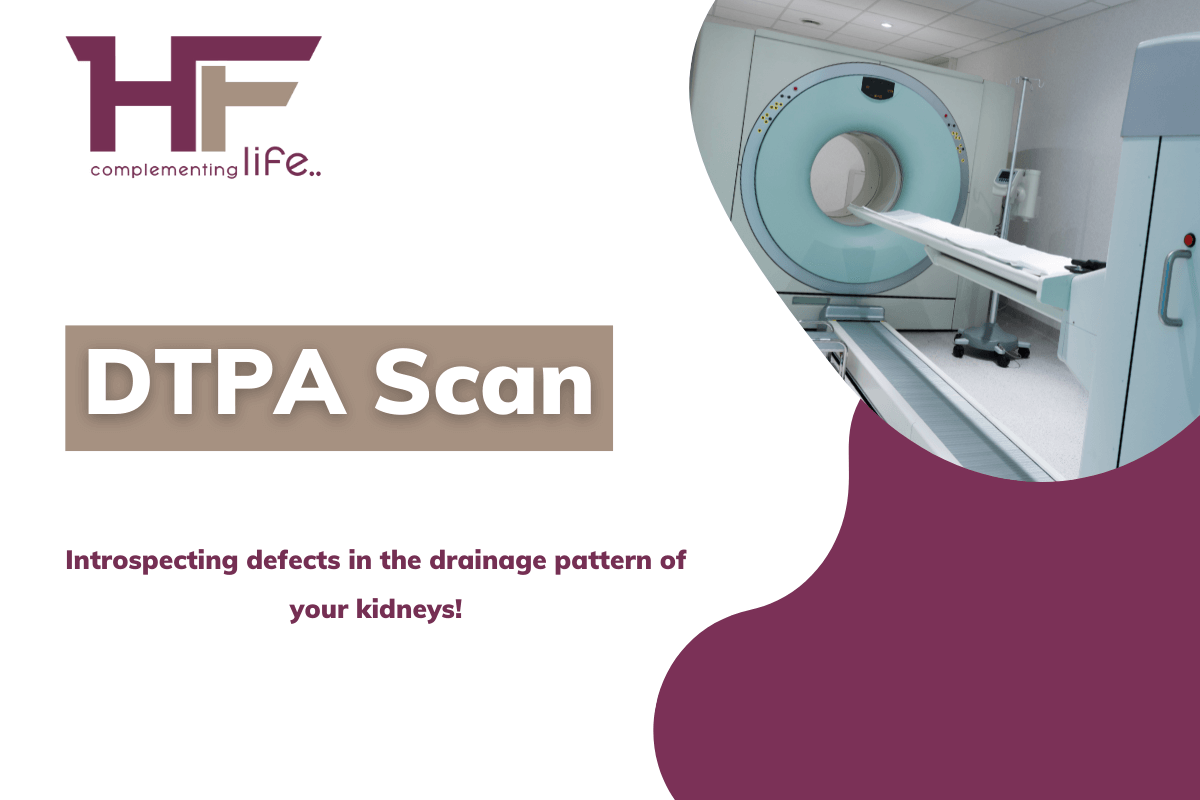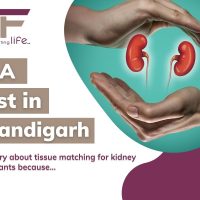Did your doctor ask you to undertake a DTPA scan? And is that what you are searching for all across the web?
Halt!
Before pursuing a DTPA scan, why not learn about what it is exactly?
That can help you understand your kidney problem and curb whatsoever deficits there be, together with your doctor and the team of healthcare service providers.
Your kidney, responsible for draining out the liquid wastes called urea from the blood in the form of urine, has most likely shown a sign of abnormality. Maybe it has stopped producing the hormonal renin that regulates blood pressure. Or maybe it fails to maintain the balance of chemicals like sodium and potassium in your blood.
In fact, there is a possibility that your kidneys cannot anymore produce the hormonal calcitriol that renders calcium to the bones or maybe shows a fall in the production.
Sometimes, your kidneys show imbalances in producing the hormonal erythropoietin that stands vital for enhancing the growth of red blood cells in your body.
Well, cysts and stones in your kidney can also be an underlying subject of your health issue.
Perhaps, either of these deficits might have been the reason for your doctor to seek a diagnostic test of your kidneys and examine accurately what it is that bothers you so much at night with abdominal pain.
However, unless the diagnosis is performed, the actual cause can be barely identified, especially because the signs of abnormalities that appear in front of us, in this regard, are almost similar to that of other gastrointestinal or urinary problems!
Now, you are possibly thinking and asking yourself – is that why a DTPA test is undertaken?
We shall see that down the line. Hold on to this article if you want an encyclopaedic alternative in learning about DTPA scan!
CContents
Why is a DTPA scan performed?
A DTPA scan, also known as Renal DTPA scan, is prescribed by doctors to assess the entire functional and structural system of your kidneys when unusual symptoms pop up. The doctors want to locate and treat the health problem accurately. So, he or she evaluates –
- The supply of blood to your kidneys,
- Excretion of urine from your kidneys, and
- The function of each kidney towards the functioning of kidneys altogether.
That’s not the end!
The diagnosis serves a lot of purposes, actually. The results of your kidney scan shall help the doctor in the assessment of conditions like –
- Renal artery stenosis, where the arteries bringing blood to your kidneys tend to become much narrow. Thus, the oxygen-rich blood cannot reach your kidneys. In turn, hampering the waste filtration process of your body system.
- Reno-vascular hypertension. It is a condition in which the arteries of your kidneys shrink to perform their regular function. Instead, your kidneys start producing a hormone that makes your blood pressure rise above the normal bar.
- Problems in the renal tubular perfusion, the process by which your body fluids undergo circulation within your kidneys and are required to maintain the normal urine output. Well, inadequate renal perfusion can lead to a decrease in the glomerular filtration rate. Therefore, increasing tubular resorptive mechanisms. Such a condition generally results from reduced cardiac output or hypotension.
- Renal tubular damage or obstruction, also regarded as acute tubular necrosis. In this particular case, your ureter gets blocked or is interrupted due to some heavy internal injury or acute trauma.
After the diagnosis is performed, the doctor shall surely carry out the treatment accordingly.
Wait!
There is something new to it. And we are going to discuss what makes the DTPA scan unique as we proceed to the next segment of our article. So, sit back, and read with me.
What’s new?
Do you know this particular procedure has got various names to it? It is sometimes called a renogram. Sometimes, renal imaging, and sometimes, renal scintigraphy. Yeah, names that are commonly unheard of! But that is not the newness we are talking about.
It is unique because it serves as both a process of diagnosis as well as treatment. That’s right! This advanced system of kidney management helps in diagnosing and treating various defects of your kidneys like –
- Inflammation of your kidneys or one of them may be due to certain kinds of infections, an overdose of certain drugs, or congenital disorders. This condition, in medical terms, is called glomerulonephritis.
- Presence of tumors in your kidneys or the lining of it, benign or malignant in nature.
- Presence of cyst (a small sac of fluids) in your kidneys or the surrounding areas, or polycystic kidney disease where myriads of such cysts grow, interfering in the kidney functions.
- Appraisal of any sort of abnormalities after undertaking kidney transplant.
- Conditions like Renovascular hypertension, as already discussed before.
- Blockage of arteries.
- Or kidney failure, the last stage of chronic kidney disease, further swelling up your legs and ankles. When approximately less than 15% of your kidney functions remain normal, the condition is proclaimed as kidney failure.
The latest and innovative technology of the renal DTPA scanning process involves a gamma camera that takes multiple images of your kidneys with precision. So, the doctor’s taka of analysis gets much easy. The structural and functional defects, if any, are spot-on in the imaging!
Usually, dual-head SPECT gamma cameras are used, here. This multipurpose SPECT system fosters accuracy by combining versatility with high-quality performance.
Symbia E and Symbia S are what medical science calls the cameras to be!
And this technique is much safer than any other diagnostic procedure, especially X-rays. It is because the amount of radiation is as minimal as it can be. Therefore, the risk of exposure to radioactive rays and further rise of complications like kidney cancer is negligible.
Now that you know what is the pursuit of the scan, it is time to learn about the procedure that you are going to undertake soon.
Do you know what DTPA stands for? I mean, the full form! DTPA is the short form doctors use to state diethylenetriamine pentaacetic acid. It is nothing but a medicine, a radiopharmaceutical medicine that you have to intake during the process of diagnosis.
Are you wondering how and why do you have to intake that medicine to test the kidneys? Look below to learn about the procedure entirely alongside the necessary preparation that you have to undertake.
Discussing the procedure and its preparation!
Since any change in the functioning of your kidneys happens at a slow pace and without any clear red flags, blood and urine tests do not always suffice. In terms of identifying the exact reasons for our compromised kidney functions, these radiopharmaceutical medicines or radioisotopes are used. Precisely as the agents of accurate diagnosis.
Usually, these medicines are provided to you in the form of pills or capsules. But, sometimes, they also come in the form of liquid that you have to intake. Or is injected into the veins of your arms with an IV needle. In the case of kidney diagnosis, injection is mostly the way out.
The energy the DTPA emits aid in the process of producing clear images of your kidneys. It is because these specific categories of drugs can pinpoint the biochemical or molecular activities inside your body. And in this context, your kidney cells.
It clearly shows that the process of DTPA scan is non-invasive in nature and does not involve any wear and tear in your body.
The DTPA selectively locates the site of your disease within the kidneys and releases gamma rays (called positrons) to bring in front of us digital imaging. Simultaneously, it engages in active participation to check whether your body is responding to a particular treatment in the very same way as the former. Two purposes served with one solution, indeed!
Conceding the procedure, you will be primarily given enough water to drink so that your body gets hydrated prior to the scanning process. Then, the radiologist will measure your height and weight.
Here, we must note that the test is usually performed on an outpatient basis. But, in the case of emergencies, it is also performed during your hospital stay. And the doctor will ask you to clear the bladder before the clinical line of the action takes place.
After that, a minor period of wait! It is for obtaining a requisite blood sugar level as per the glucose leading flowchart. Once that is attained, you will be asked to enter the examination room.
The moment you step in, the different cameras and other devices will catch hold of your sight. And so will the examination table! This is thy place where you have to lie down for the scan.
Relax! Take a deep breath and march forward. You will not be hurt in this process. However, a bit of panic or disturbances in the scanning process can disrupt the accuracy. Now, you have to lie down in the examination bed or table, with a gamma camera placed under it. Alert Once again! Any kind of movement can lead to blurry images. So, you have to stay as still as you can.
Then, the doctor shall insert a cannula in your superficial veins through which the radiopharmaceutical will go inside your body. It may pave for a pinch-like sensation, but that is all! Once the cannula goes in, there is no pain as such.
Following this, the radiologist will move the cameras to take pictures from different angles. And when that is complete, the radiologist shall remove the cannula or intravenous line.
And after fifteen minutes, you shall get another injection. This time it works to restrict your kidneys from reabsorbing the water to a large extent, and rather, stimulates the formation of urine. As the flow of urine through your ureter increases, the obstructions can be seen, clearly.
Finally, you have to wait for the reports to come. Do not worry! Your doctor will discuss the reports with you thoroughly.
But, before the scan, you ought to prepare for it. How?
Step 1 – You have to keep your body hydrated by drinking a lot of fluids, but not hard liquor, of course. The doctors suggest a minimum of eight glasses of water in a day for the method. Follow this routine for a week or so.
Step 2 – if you are pregnant or breastfeeding your child, discuss it with your doctor before up-taking the test. It is because the radioactive substances can pose a threat if the amount is not regulated respectively here.
Step 3 – When you are under any sort of medications or supplements, you have to stop consuming that at least 4 to 7 days before the test.
Step 4 – Disclaimer! Always inform your doctor about the allergies you have before the scan to avoid future setbacks.
Step 5 – If you have pursued any tests previously, bring along the reports with you along with the prescription to the diagnostic center. Such preparation is essential for devising the plan of diagnosis.
Step 6 – You may or may not be asked to change your attire, depending upon the criteria of the radiologist labs. But, removing metal objects like belts or pieces of jewelry stands crucial. Why so? Certainly, it is because the presence of metal can interfere in the process of capturing radioactive emissions. Thereupon, manifests poor scan results!
That is all! You are now set to go for your Renal DTPA scan and introspect the problems in the drainage patterns of your kidneys.
Yet again, a question is likely to come up. Why not any other scan? Why DTPA renogram? How can this test benefit, unlike other tests? What are the perks? Is there a perk at all?
Certainly, there are! And we shall glance through them in the next segment. Hence, continue to watch out.
Benefits of DTPA scan!
No doubt, every new technological and scientific innovation in the field of healthcare and wellness comes with certain benefits. So does the Renal DTPA scan! Let us find out what they are.
- Painless procedure – While pursuing any kind of test, what scares us most is definitely, whether it can cause any pain. Even though the perception of pain varies from person to person, but the DTPA scan is an absolutely painless procedure. You may only feel a little discomfort while lying still continuously. Or, maybe during the insertion of the intravenous line. Otherwise, it is not.
- Early diagnosis – As the renal DTPA scan involves only fifteen to twenty minutes, a hospital stay is not necessary at all, except for a case of emergency, like severe internal injury or the last stages of kidney cancer. Yes, this process allocates early diagnosis, and you can walk out on the very same day. In fact, the test results shall also reach you on the very same day or the next.
- Vividly reveals the precise stage and location of the defect – Perhaps, renal DTPA scan administers accuracy to its peak. It critically reveals the location of your defect with red spots in the image, be it structural or functional. Likewise, the test can also tell you the specific stage o your disorder. Therefore, making it easier for your doctor to take up the suitable treatment.
- Facilitates going back to the normal course of life quickly – By now, you know that the process does not enlist any kind of cuts in your body, nor is it prolonged or time-taking. By acknowledging the facets of modern-day’s fast and busy world, medical science came up with a diagnostic process that can leave rooms for you to return to the normal chores of your life as quickly as possible and continue the regular activities of your life. Undoubtedly, such an aspect is beneficial for people who work under tight schedules.
- No further complications – As repeated many a time in this article, the process does not indulge in any invasion inside your body. It means there will be no blood loss. That is why the chance of further complications does not really exist here. There can be a few mild side effects (which we are going to discuss in the next segment), but no such serious setbacks.
- Acts as a novel therapeutic modality in some cases – The DTPA being a medicine makes the process unlikely to the other diagnostic methods. It sometimes acts as a therapeutic model to kill cancerous cells or lumps in your kidneys and even offers a comprehensive cure for conditions like polycystic kidney disease, benign tumors, swelled up glomeruli, and so forth. We can say it is a twin-fold model of the latest medical progress. Diagnosis and therapy, together in one stroke!
Whenever we talk about benefits, the human mind also asks for the contrary, the risk factors, to be precise. Now, you must be expecting to learn about the side effects.
Are there any? Let us see!
Are there any side effects?
Beware! Here comes some of the side effects of renal DTPA scans, even though the benefits surpass them mostly!
One condition that almost everyone witnesses after the test but is not anything to fear is body dehydration. You shall feel thirsty very frequently and crave fluids all day round. And corollary shall want to go to the toilet at smaller intervals to empty to bladder again and again. Seem hilarious but tiring, of course.
On the same ground, you may feel a metallic taste in your mouth, a sort of irritation in your throat. Such an after-effect is because of the radionuclide. Additionally, you may face other mild side effects like –
- Headache,
- Chest pain,
- Rashes,
- Redness in the skin, or
- Light-headedness.
But, these conditions shall go away naturally within a day or two. Yet, there are some aspects of the scan you should be cautious about. And they are –
- Exposure to excess radiation leads to cancer – It is true! If the dosage of the radioactive isotope, the DTPA, goes up the limit, cancerous cells can form and spread in your body. Hence, it is also necessary to undertake a DTPA scan from a certified lab where the radiologist of the nuclear department knows the fine line perfectly.
- The contrast dye used sometimes can pose a threat – Despite being rare, the use of contrast dye, a kind of tracer prescribed by doctors to administer the vein prior to the scanning procedure, can cause extensive allergic reactions. It is why we would always suggest that you opt for a DTPA scan from a NABL certified lab or a NABH accredited hospital or clinic in Chandigarh.
- Pregnant women can lose the fetus – Yeah, a DTPA scan is in no way favorable for pregnant women as there may be a possibility of losing the fetus because of radiation. In that case, the doctor suggests some other tests which do not involve any radiation. It is upon you to remember this particular setback and inform your doctor beforehand.
Note that the dosage of radiation is very low to even come up with a side effect.
Final thoughts
Are you still there, finding the answers to your questions about the DTPA scan? Well, we shall have to wrap up now. The article mentions all necessary details concerning a renal DTPA scan used for examining your kidneys. The only thing left to talk about is, certainly, the cost! In this context, diversity is all we see. In terms of location and quality of the laboratory, the price differs hugely. If you ask for an average, that shall be around Rs. 4000-5000 approximately.
Are you looking for a discounted price? You have come to the right place!
We, at Health Finder, connect patients to NABL certified labs in Chandigarh on our online healthcare and wellness marketplace with enormous discount opportunities. And that too without any waiting list, unlike the government hospitals that are crushing under the rush of patients.
So, what are you waiting for? Book an appointment at your own time and get your renal DTPA scan done!
Serving patients with high-quality medical care stands to be our pursuit of endeavor!










Comments